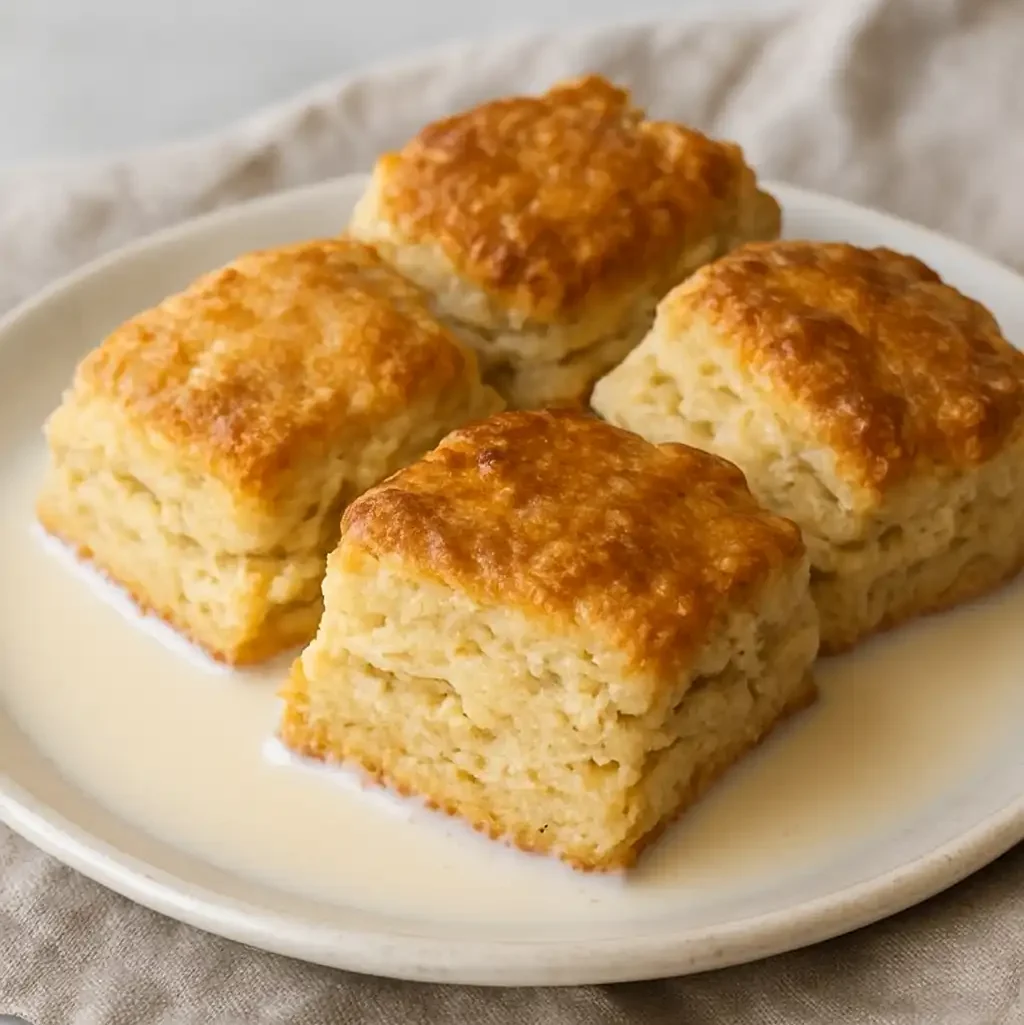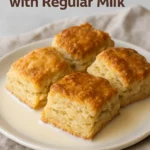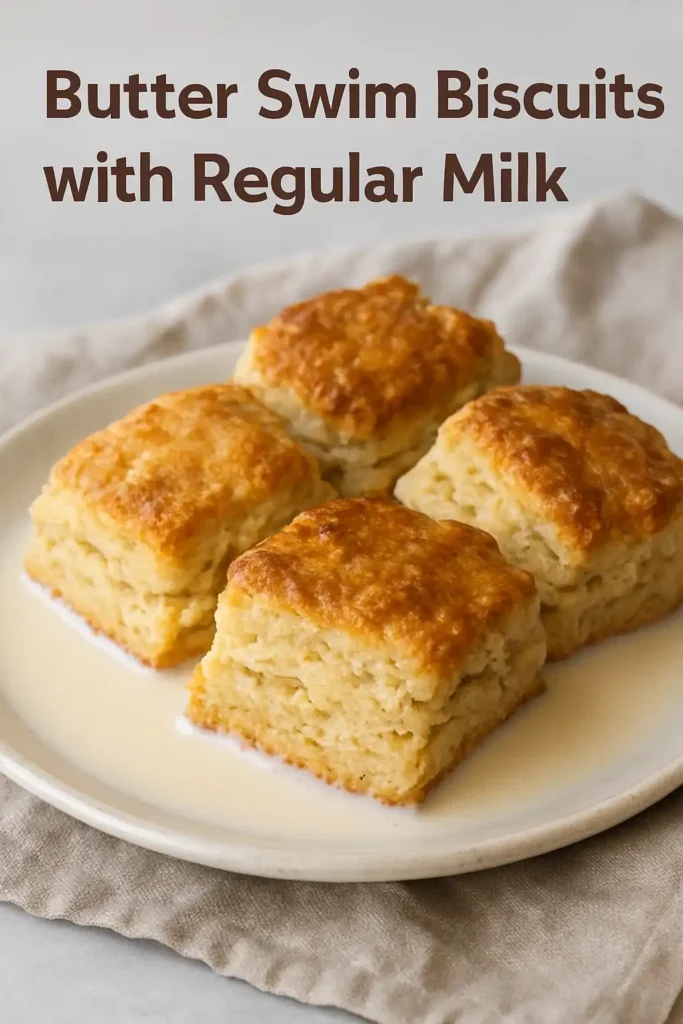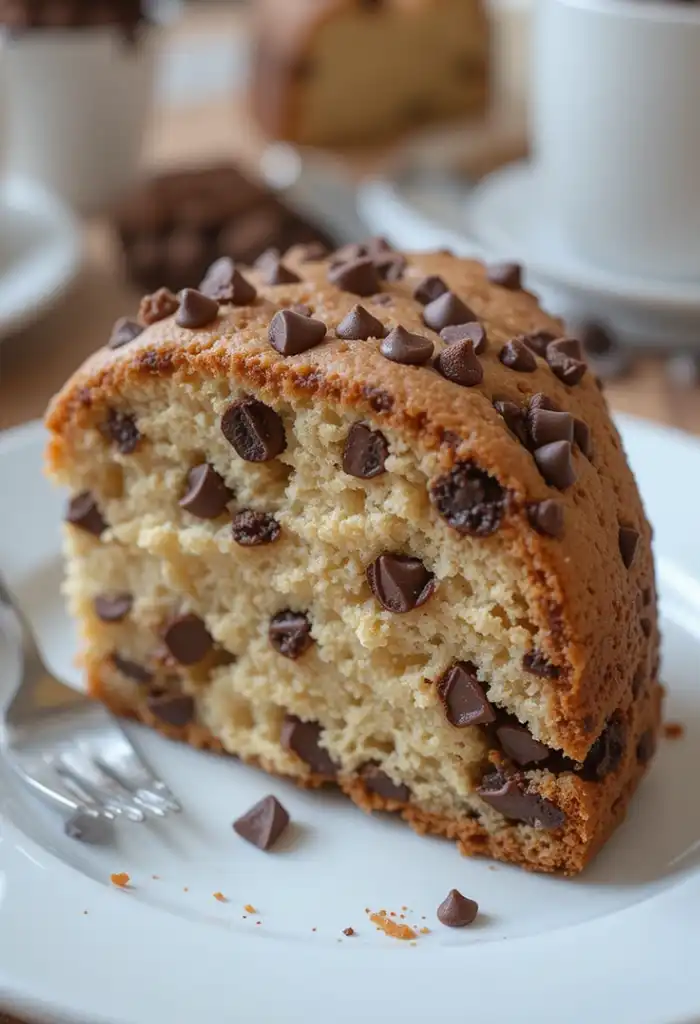Butter swim biscuits are Southern-style goodies known for their buttery flaky texture. There is no kneading or rolling; the batter is just poured into a pan of melted butter and baked to a lovely golden brown. The biscuits are crispy on the outside but tender and light on the inside. The traditional liquid used is buttermilk because of its distinctive tangy taste and the fact that it works so well with the leavening agents like baking powder.
But many home bakers want to know if butter swim biscuits can be made with plain milk when buttermilk is finished. Well, the good news is: it can! It changes the flavor and texture a bit, but gives you a fluffy, yummy biscuit that can stand up to breakfast, dinner, or a great snack in the afternoon.
In this way, by getting familiar with the differences between buttermilk and regular milk and taking a few pointers, you’ll be able to bake biscuits that are just as delectable.
Traditional Ingredients in Butter Swim Biscuits
Butter swim biscuits are loved for their simplicity, which makes for a very accessible recipe for novice and veteran bakers alike. Traditionally, the main ingredients are all-purpose flour, baking powder, salt, sugar (optional), buttermilk, and, of course, butter. Each ingredient thus has a specified role in affecting the texture and flavor.
Buttermilk is often considered the secret ingredient, as it contributes to the lift of the biscuit through the acid reacting with baking powder while imparting a distinct sourness to the biscuit. Butter, rich and yellow, contributes to melt-in-your-mouth goodness and the biscuit’s crust. Flour provides for structure, while baking powder causes lift.
Substituting buttermilk for regular milk alters the chemical makeup to some extent. Regular milk is not acidic, and as such, the biscuits may not be as tall and their flavor will not be tangy. But not to worry; with a few tweaks such as a squeeze of lemon juice or a splash of vinegar with the milk, you can achieve a buttermilk-like function and sweet, fluffy, tender biscuits.
Can You Substitute Regular Milk for Buttermilk?
This is the big question many bakers ask: Can I really make butter swim biscuits with regular milk? And the answer is absolutely “yes.” The substitution works; the outcome, however, may vary slightly according to the type of milk – whole, low-fat, or skim.
Use whole milk instead, as it is fat enough to make them richer. Low-fat milk can still be used, but the biscuits aren’t going to be quite as soft. I do not recommend skim milk, as it won’t add any creaminess for getting fluffy inside.
If you want to get a little closer to buttermilk, you could take a little kitchen trick: for every cup of milk, add one tablespoon of lemon juice or white vinegar, and let it sit for about 5–10 minutes. You’d know it’s working when you see the milk thickening a bit. The added acidity makes the biscuits rise better and provides a flavor even closer to traditional buttermilk biscuits.
So yes, you can definitely use normal everyday milk to make butter swim biscuits, and a small tweak can get the outcome to taste and feel just as good as the classic version.
Step-by-Step Recipe Using Regular Milk
Making butter swim biscuits with regular milk is straightforward and doesn’t require advanced baking skills. This recipe yields fluffy biscuits with a golden, buttery crust that will have your kitchen smelling heavenly.
Ingredients Needed
- 2 ½ cups all-purpose flour
- 2 tablespoons granulated sugar (optional)
- 4 teaspoons baking powder
- 1 teaspoon salt
- 1 ¾ cups regular whole milk (or milk + lemon juice for acidity)
- ½ cup unsalted butter (1 stick), melted
Mixing the Dough
Start by preheating your oven to 450°F (232°C). While the oven warms up, pour the melted butter into a 9×13-inch baking dish. In a separate large bowl, whisk together flour, sugar, baking powder, and salt. Slowly add the milk and stir until just combined. Avoid overmixing, as this can make the biscuits tough.
Pour the dough directly into the buttered pan. Use a spatula to spread it evenly, allowing the melted butter to coat the dough. You’ll notice the dough absorbing some butter, which helps create the signature crispy, golden edges.
Baking Process
Once the dough is evenly spread, score it into square or rectangular portions with a sharp knife. This makes cutting easier after baking. Place the dish in the preheated oven and bake for about 25–30 minutes, or until the top is golden brown.
When finished, let the biscuits cool for a few minutes before serving. The result will be tender, fluffy biscuits with a buttery crust that pairs beautifully with honey, jam, or gravy.

Tips for Perfect Butter Swim Biscuits with Regular Milk
While making butter swim biscuits with regular milk is simple, a few tips can ensure your biscuits come out just as fluffy and golden as the buttermilk version.
- Choose whole milk when possible – The extra fat adds richness and tenderness that low-fat or skim milk can’t replicate.
- Don’t overmix the dough – Stir until the ingredients are just combined. Overmixing develops gluten, which makes biscuits dense instead of soft.
- Let the dough rest for a few minutes – Allowing it to sit helps the flour hydrate fully and creates a smoother texture.
- Preheat your oven properly – A hot oven ensures the biscuits rise quickly and evenly, giving you that light, fluffy interior.
- Score the dough before baking – Cutting into squares before baking makes the biscuits easier to separate and allows butter to seep into each piece.
- Add acidity if possible – A teaspoon of vinegar or lemon juice in the milk brings the texture closer to traditional buttermilk biscuits.
By following these tips, you’ll get biscuits that are buttery, soft on the inside, and crisp on the outside, proving that butter swim biscuits with regular milk can be just as satisfying as their buttermilk counterpart.
Taste and Texture: Buttermilk vs Regular Milk
When comparing butter swim biscuits made with buttermilk versus those made with regular milk, the differences are subtle but noticeable.
- Flavor: Buttermilk provides a tangy, slightly sour note that balances the richness of butter. Regular milk creates a milder, creamier taste without that tang.
- Texture: Buttermilk’s acidity reacts with baking powder, giving biscuits more lift and fluffiness. Regular milk produces a softer, denser crumb unless acid is added.
- Color: Both versions brown beautifully, but biscuits with buttermilk sometimes develop a slightly deeper golden crust.
- Moisture: Whole milk helps keep biscuits moist, while lower-fat milk can make them slightly drier.
That said, the difference isn’t drastic. Many people actually prefer butter swim biscuits with regular milk because they find the flavor smoother and less sharp. The buttery crust remains the star of the recipe, regardless of which milk you use.
If you want the best of both worlds, you can always enhance regular milk with a splash of lemon juice or vinegar to mimic the chemistry of buttermilk while keeping the creaminess of whole milk.
Common Mistakes to Avoid
Even though butter swim biscuits with regular milk are easy to prepare, a few common mistakes can lead to less-than-perfect results. Here’s what to watch out for:
- Overmixing the dough: This is the number one reason biscuits turn tough instead of soft and fluffy. Mix until ingredients are just combined.
- Using cold butter in the pan: The butter must be melted before adding the dough. Otherwise, the biscuits won’t get that signature crispy bottom.
- Incorrect oven temperature: Too low, and the biscuits will dry out before browning; too high, and they’ll burn on the outside while staying raw inside.
- Not scoring before baking: This makes cutting difficult after baking and prevents even butter distribution.
- Skipping the resting time for milk + acid: If you’re making a homemade buttermilk substitute, let it sit for at least 5–10 minutes to develop acidity.
By avoiding these pitfalls, you’ll ensure your butter swim biscuits with regular milk turn out light, golden, and absolutely delicious every time.
Variations You Can Try with Regular Milk
One of the best things about making butter swim biscuits with regular milk is their versatility. You can easily customize the recipe to fit your cravings or occasion without losing that signature buttery goodness.
Adding Cheese
Cheese lovers will adore a cheddar variation. Simply mix one cup of shredded sharp cheddar into the dry ingredients before adding the milk. The cheese melts into the biscuits as they bake, creating pockets of savory richness that pair perfectly with soups, stews, or breakfast dishes. For extra flavor, sprinkle a little cheese on top before baking.
Making Sweet Versions
If you prefer something on the sweeter side, try adding two tablespoons of sugar to the dough and topping the biscuits with a cinnamon-sugar sprinkle before baking. These sweet butter swim biscuits with regular milk make an excellent breakfast treat or dessert when served with honey or fruit preserves.
Other fun variations include adding garlic and herbs, incorporating jalapeños for a spicy kick, or brushing the finished biscuits with honey butter for a glossy, sweet finish. The possibilities are endless, proving just how adaptable this recipe can be.
Storage and Reheating Tips
Butter swim biscuits with regular milk taste best when fresh out of the oven, but leftovers can still be delicious if stored properly.
- Room temperature: Store cooled biscuits in an airtight container for up to two days.
- Refrigeration: If you want them to last longer, place them in the refrigerator, where they’ll stay fresh for up to five days.
- Freezing: For long-term storage, freeze biscuits in a single layer on a baking sheet, then transfer to a freezer-safe bag. They can last up to three months this way.
When reheating, avoid using the microwave, as it can make biscuits soggy. Instead, warm them in a 350°F (175°C) oven for about 8–10 minutes, or until heated through. If you want to revive the buttery crust, brush lightly with melted butter before reheating.
Following these storage and reheating tips ensures that your butter swim biscuits with regular milk stay just as fluffy and flavorful the next day.
Serving Suggestions & Pairings
Butter swim biscuits with regular milk are ridiculously versatile—think breakfast, brunch, or cozy weeknight dinners. Serve them warm with salted butter and a drizzle of honey for a simple treat, or go savory with sausage gravy, fried eggs, and crispy bacon. For a hearty dinner side, pair with roasted chicken, creamy soups like potato or tomato bisque, or a chunky beef stew.
Craving something lighter? Split a biscuit and add sliced tomatoes, a swipe of mayo, flaky salt, and cracked pepper for a quick Southern-style snack. For a sweet spin, brush warm biscuits with melted butter and sprinkle cinnamon sugar. Because butter swim biscuits with regular milk bake up with golden, crispy edges and a tender center, they also make a great base for mini breakfast sandwiches—layer with scrambled eggs, cheddar, and spinach for a portable bite.
If you’re entertaining, set up a biscuit bar: butter (plain and honey), jams, a whipped herbed cream cheese, and thin slices of ham. It’s laid-back, crowd-pleasing, and lets everyone build their perfect biscuit without fuss.
Equipment & Tools You’ll Need
You don’t need specialty gear to make butter swim biscuits with regular milk, but good basics help you nail consistent results.
- 9×13-inch baking dish (metal for extra-crispy edges, glass for steady browning)
- Large mixing bowl and sturdy spatula
- Measuring cups & spoons (level off flour for accuracy)
- Whisk (for even distribution of baking powder and salt)
- Sharp knife or bench scraper (for scoring the dough)
- Oven thermometer (optional, but great for confirming your oven is truly at 450°F / 232°C)
A digital scale is optional, but weighing flour (300 g per 2½ cups) helps avoid dense biscuits. Consistency matters, especially when you’re making butter swim biscuits with regular milk and chasing that perfect rise.
Ingredient Swaps & Smart Alternatives
Life happens, pantries vary—here are flexible swaps that still deliver great biscuits.
- Flour: Use self-rising flour and omit the baking powder and salt.
- Butter: Salted butter works—just reduce added salt slightly. Ghee adds a nutty aroma and browns beautifully.
- Milk: Whole milk is best, but 2% works. If you want more tang and rise, add 1 Tbsp lemon juice or white vinegar per cup, let it sit 5–10 minutes, then use as your “buttermilk.”
- Gluten-friendly tweak: Replace up to 25% of flour with fine whole wheat for a heartier crumb.
- Dairy-light option: Combine ¾ cup milk + ¼ cup plain yogurt per cup of liquid to mimic body and tang.
These swaps keep butter swim biscuits with regular milk soft, flavorful, and reliable, even when you’re improvising.
Quick Reference Table: Milk Types & What to Expect
| Milk Type | Rise | Crumb | Flavor | Notes |
|---|---|---|---|---|
| Whole Milk | Good | Tender | Mild, creamy | Best default for balance |
| 2% Milk | Moderate | Slightly less tender | Mild | Add 1 tsp vinegar per cup for lift |
| Skim Milk | Lower | Drier | Neutral | Not ideal; consider yogurt add-in |
| Milk + Lemon/Vinegar | Higher | Fluffy | Slight tang | Closest to classic buttermilk feel |
| Milk + Yogurt (¾:¼) | Higher | Moist | Tangy | Great for structure and richness |
Use this as a cheat sheet whenever you’re making butter swim biscuits with regular milk and want to fine-tune texture.
Make-Ahead, Freeze, & Meal-Prep Plan
If you love fresh biscuits but hate the clock, this is your playbook:
- Make-Ahead Dough: Mix dry and wet separately. Combine just before baking for best lift.
- Par-Bake & Freeze: Bake until just barely golden (about 20 minutes), cool, wrap, and freeze up to 3 months. Reheat at 350°F (175°C) for 10–12 minutes.
- Freeze Baked Biscuits: Cool completely, freeze on a tray, then bag. Reheat straight from frozen at 350°F for 12–15 minutes.
- Revive the Crust: Brush with a little melted butter before reheating. It restores that signature “swim” sheen.
With these strategies, you can enjoy butter swim biscuits with regular milk any busy morning without sacrificing quality.
Troubleshooting: Why Didn’t They Rise? (And Quick Fixes)
| Problem | Likely Cause | Fast Fix |
|---|---|---|
| Dense biscuits | Overmixed dough | Stir only until just combined; lumps are okay |
| Pale tops | Oven under-temp | Verify 450°F with an oven thermometer |
| Greasy bottom | Too much butter or small pan | Use a true 9×13 and stick to ½ cup butter |
| Meh flavor | Low fat milk | Use whole milk or add yogurt for body |
| Crumbly texture | Not enough liquid | Add 1–2 Tbsp milk to loosen dough |
| Uneven browning | Pan placement | Bake on center rack; rotate at 15 minutes |
Keep this handy the next time you’re baking butter swim biscuits with regular milk—most issues are quick to correct.
FAQs
1) Can I really make butter swim biscuits with regular milk and still get height?
Yes. Whole milk alone works, but mixing 1 cup milk + 1 Tbsp lemon juice or white vinegar and resting 10 minutes creates acidity that improves rise and tenderness.
2) What if I only have skim milk?
You’ll still get biscuits, but they’ll be drier and less tender. Add 2 Tbsp plain yogurt per cup or a spoon of melted butter to improve body when making butter swim biscuits with regular milk that’s fat‑light.
3) Do I need baking soda if I add vinegar to milk?
Not required for this recipe if you’re already using baking powder. Baking soda needs acid; baking powder contains its own. Stick with 4 tsp baking powder unless you’ve significantly changed the formula.
4) Can I reduce the butter in the pan?
You can drop to 6 Tbsp and still get good results, but that signature crisp, buttery bottom is best with a full ½ cup when making butter swim biscuits with regular milk.
5) Why are my biscuits tough?
Overmixing. Stir just until no dry flour streaks remain. Some lumps are fine. Toughness comes from excess gluten development.
6) Can I make them sweet?
Absolutely. Add 2–3 Tbsp sugar to the dough and finish with cinnamon sugar or honey butter. Sweet butter swim biscuits with regular milk are fantastic with fruit preserves.
7) Can I add cheese and herbs?
Yes! Fold in 1 cup sharp cheddar and 1–2 tsp chopped herbs (chives, parsley). Brush tops with garlic butter for a cheddar‑bay vibe.
8) Can I use self‑rising flour?
Yes—omit baking powder and salt. Self‑rising flour makes butter swim biscuits with regular milk extra simple and consistent.
9) How do I reheat without drying them out?
Bake at 350°F (175°C) for 8–10 minutes. Brush with a touch of melted butter before reheating to refresh moisture and shine.
10) Do these freeze well?
They freeze beautifully. Cool, freeze on a tray, bag, and reheat from frozen at 350°F for 12–15 minutes.
11) What if I don’t have a 9×13 pan?
Use a 10-inch cast‑iron skillet or an 11×7 dish (add 2–4 minutes to the timing). Depth and material affect browning, so keep an eye on the edges.
12) Can I make the dough ahead and bake later?
Mix dry and wet separately; combine right before baking for best lift. Pre‑mixed dough loses some oomph if it sits too long.
13) Are butter swim biscuits with regular milk good for breakfast sandwiches?
They’re perfect. The crisp edges and soft centers hold eggs, cheese, and sausage without crumbling.
14) How many times should I use the knife to score?
Score into 12 rectangles or 16 squares. Deep scoring channels butter into every biscuit and makes serving cleaner.
15) Can I make them gluten‑free?
You can try a 1:1 gluten‑free baking blend plus ½ tsp xanthan gum if not included. Texture will be a bit more tender; bake until deep golden for structure.
Related Posts:
https://dailytastebites.com/rhubarb-pudding-bars/
https://dailytastebites.com/healthy-oatmeal-chocolate-chip-bars/
https://dailytastebites.com/cranberry-white-chocolate-oatmeal-cookies/
Conclusion
So—can you make butter swim biscuits with regular milk? Absolutely, and you can make them spectacular. Whole milk alone yields a soft, creamy crumb and golden crust, while a quick acid boost (lemon juice or vinegar) delivers lift and a hint of tang that mimics classic buttermilk. Keep your oven truly hot, avoid overmixing, score generously, and don’t skimp on that buttery “swim”—it’s the secret to crisp edges and tender centers.
Whether you’re serving them with jam at brunch, dunking into stew at dinner, or building mini breakfast sandwiches, butter swim biscuits with regular milk are a dependable, crowd‑pleasing staple. With the tips, swaps, and troubleshooting guides above, you’ll turn out bakery‑level biscuits from an everyday pantry—no buttermilk required.
For a reliable primer on quick buttermilk substitutes and why acidity matters in baking, see King Arthur Baking’s guide to buttermilk substitutes: https://www.kingarthurbaking.com/blog/2019/01/28/how-to-substitute-for-buttermilk
Print
Can I Make Butter Swim Biscuits With Regular Milk
- Prep Time: 10 minutes
- Cook Time: 25–30 minutes
- Total Time: 35–40 minutes
- Yield: 9–12 biscuits 1x
- Category: Bread / Side Dish
- Method: Baking
- Cuisine: American
- Diet: Vegetarian
Description
Fluffy on the inside and crispy on the outside, these butter swim biscuits with regular milk are simple, buttery, and absolutely delicious. Perfect for breakfast, dinner sides, or a cozy snack—no buttermilk needed!
Ingredients
- 2 ½ cups all-purpose flour
- 4 tsp baking powder
- 1 tsp salt
- 2 tbsp sugar (optional)
- 1 ¾ cups whole milk (or milk + 1 tbsp lemon juice)
- ½ cup unsalted butter, melted
Instructions
- Preheat oven to 450°F (232°C).
- Pour melted butter into a 9×13-inch baking dish.
- In a mixing bowl, whisk flour, baking powder, salt, and sugar.
- Add milk slowly and stir until just combined. (Do not overmix.)
- Spread dough evenly into the buttered pan.
- Score dough into squares/rectangles with a sharp knife.
- Bake for 25–30 minutes, until golden brown on top.
- Let cool slightly, cut along scored lines, and serve warm.
Notes
Tip: These biscuits taste best fresh out of the oven. Store leftovers in an airtight container and reheat before serving for maximum flavor.
Nutrition
- Serving Size: 1 bicuit
- Calories: ~240 kcal
- Sugar: 3g
- Sodium: 420mg
- Fat: 15g
- Saturated Fat: 9g
- Unsaturated Fat: 5g
- Trans Fat: 0g
- Carbohydrates: 23g
- Fiber: 1g
- Protein: 4g
- Cholesterol: 40mg




